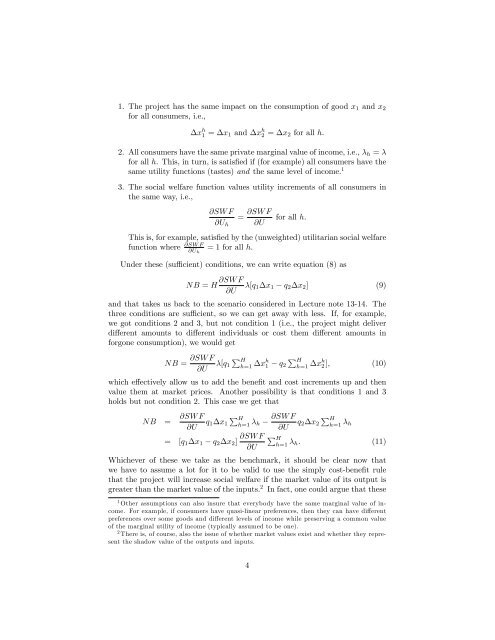Lecture Note 15: Social Cost Benefit Analysis - University of ...
Lecture Note 15: Social Cost Benefit Analysis - University of ...
Lecture Note 15: Social Cost Benefit Analysis - University of ...
Create successful ePaper yourself
Turn your PDF publications into a flip-book with our unique Google optimized e-Paper software.
1. The project has the same impact on the consumption <strong>of</strong> good x1 and x2<br />
for all consumers, i.e.,<br />
x h 1 = x1 and x h 2 = x2 for all h:<br />
2. All consumers have the same private marginal value <strong>of</strong> income, i.e., h =<br />
for all h. This, in turn, is satis…ed if (for example) all consumers have the<br />
same utility functions (tastes) and the same level <strong>of</strong> income. 1<br />
3. The social welfare function values utility increments <strong>of</strong> all consumers in<br />
the same way, i.e.,<br />
@SW F<br />
@Uh<br />
= @SW F<br />
@U<br />
for all h:<br />
This is, for example, satis…ed by the (unweighted) utilitarian social welfare<br />
function where = 1 for all h.<br />
@SW F<br />
@Uh<br />
Under these (su¢ cient) conditions, we can write equation (8) as<br />
@SW F<br />
NB = H<br />
@U<br />
[q1 x1 q2 x2] (9)<br />
and that takes us back to the scenario considered in <strong>Lecture</strong> note 13-14. The<br />
three conditions are su¢ cient, so we can get away with less. If, for example,<br />
we got conditions 2 and 3, but not condition 1 (i.e., the project might deliver<br />
di¤erent amounts to di¤erent individuals or cost them di¤erent amounts in<br />
forgone consumption), we would get<br />
NB =<br />
@SW F<br />
@U<br />
PH [q1 h=1 xh PH 1 q2 h=1 xh2]; (10)<br />
which e¤ectively allow us to add the bene…t and cost increments up and then<br />
value them at market prices. Another possibility is that conditions 1 and 3<br />
holds but not condition 2. This case we get that<br />
NB =<br />
@SW F<br />
@U q1<br />
PH x1 h=1 h<br />
= [q1 x1 q2 x2]<br />
@SW F<br />
@U<br />
@SW F<br />
@U q2 x2<br />
P H<br />
h=1 h<br />
P H<br />
h=1 h: (11)<br />
Whichever <strong>of</strong> these we take as the benchmark, it should be clear now that<br />
we have to assume a lot for it to be valid to use the simply cost-bene…t rule<br />
that the project will increase social welfare if the market value <strong>of</strong> its output is<br />
greater than the market value <strong>of</strong> the inputs. 2 In fact, one could argue that these<br />
1 Other assumptions can also insure that everybody have the same marginal value <strong>of</strong> income.<br />
For example, if consumers have quasi-linear preferences, then they can have di¤erent<br />
preferences over some goods and di¤erent levels <strong>of</strong> income while preserving a common value<br />
<strong>of</strong> the marginal utility <strong>of</strong> income (typically assumed to be one).<br />
2 There is, <strong>of</strong> course, also the issue <strong>of</strong> whether market values exist and whether they represent<br />
the shadow value <strong>of</strong> the outputs and inputs.<br />
4


